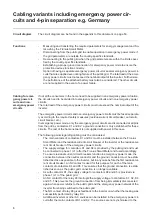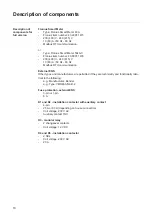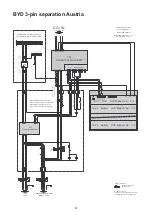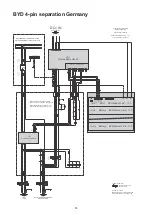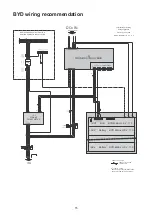
8
Cabling variants including emergency power cir-
cuits and 4-pin separation e.g. Germany
Circuit diagram
The circuit diagram can be found in the appendix to this document on page
14
.
Functions
-
Measuring and transferring the required parameters for energy management and So-
lar.web by the Fronius Smart Meter.
-
Disconnecting from the public grid to enable operation in emergency power mode if
the grid parameters are outside the country-specific standards.
-
Reconnecting to the public grid when the grid parameters are within the limits speci-
fied by the country-specific standards.
-
Establishing a proper ground connection for emergency power mode to ensure the
protection devices function correctly.
-
Option of having a separate emergency power circuit or several emergency power cir-
cuits that are supplied even during failure of the public grid. The total load of the emer-
gency power circuits must not exceed the nominal output of the inverter. Furthermore,
the performance of the attached battery must also be considered. The other circuits
are not supplied in the event of a power failure.
Cabling for emer-
gency power cir-
cuits and non-
emergency power
circuits
If not all the consumers in the home need to be supplied in an emergency power situation,
the circuits need to be divided into emergency power circuits and non-emergency power
circuits.
The total load of the emergency power circuits must not exceed the nominal output of the
inverter.
The emergency power circuits and non-emergency power circuits must be fused separate-
ly according to the required safety measures (residual-current circuit breaker, automatic
circuit breaker, etc.).
In emergency power mode, only the emergency power circuits are disconnected at all pins
from the grid by contactors K1 and K2; a ground connection is only established for these
circuits. The rest of the home network is not supplied with power in this case.
The following points regarding cabling must be considered:
-
The main contacts of contactors K1 and K2 must be installed between the Fronius
Smart Meter and the residual-current circuit breaker of the inverter or the residual-cur-
rent circuit breaker of the emergency power circuits.
-
The supply voltage for contactors K1 and K2 is provided by the public grid and must
be connected to phase 1 (L1) after the Fronius Smart Meter and fused accordingly.
-
To ensure residual-current circuit breakers function in emergency power mode, the
connection between the neutral conductor and the ground conductor must be estab-
lished as close as possible to the inverter, but in any case before the first residual-cur-
rent circuit breaker. An NC contact is used for this purpose for each of the main
contacts of contactors K4 and K5. This ensures that the ground connection is estab-
lished as soon as the public grid connection is no longer available.
-
As with contactor K1, the supply voltage for contactors K4 and K5 is provided via
phase 1 (L1) of the public grid.
-
An NC contact for the relay K3 interrupts the supply voltage to contactors K1, K2, K4
and K5. This prevents the ground connection from being immediately disconnected
again when power returns to the public grid and the emergency power network of the
inverter from being switched to the public grid.
-
The NO contact of relay K3 gives feedback to the inverter on whether the locking was
successfully performed by relay K3.
-
Additional inverters or other AC sources can be installed in the emergency power cir-
cuit after the main contacts of K1 and K2. The sources are not synchronised to the








